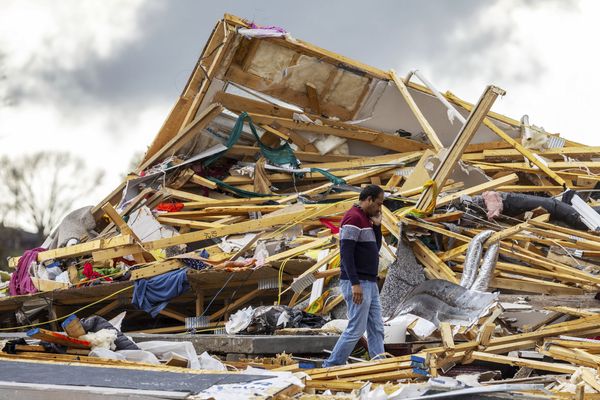
PHOENIX — Donald Trump’s latest immigration proposals would require a dramatic and costly expansion of the U.S. border-control system — targeting millions more people for immediate removal while also making it much harder for millions of others to enter the country legally.
The deportation priorities outlined by the Republican presidential nominee during a policy address here late Wednesday would target at least 5 million and as many as 6.5 million undocumented immigrants for swift removal, or about half of the 11 million estimated to be living in the United States. And he left open the possibility that he would seek to deport many more as well.
“Anyone who has entered the United States illegally is subject to deportation,” Trump said.
Trump delivered a series of similarly sweeping statements and proposals during the hard-edged speech, following a tortuous two-week period in which he had signaled that he might soften his tone on the issue instead. He not only called for removing all undocumented immigrants who had committed crimes, but also said he would prioritize the deportation of those who have overstayed their visas.
To accomplish that goal, he said he would triple the number of Immigration and Customs Enforcement agents and create a “new special deportation task force” to track the most serious security threats.
“We will break the cycle of amnesty and illegal immigration. We will break the cycle. There will be no amnesty,” he said. “Our message to the world will be this: You cannot obtain legal status or become a citizen of the United States by illegally entering our country. Can’t do it.”
[Fact-checking Donald Trump’s immigration speech]
That speech, which followed a quick visit to Mexico earlier Wednesday to meet with President Enrique Peña Nieto, effectively shut down speculation that he would move toward the center on immigration issues before Election Day. Many Republican strategists hoped that such a move would help him court moderate voters and regain ground against his Democratic rival, Hillary Clinton. His speech also prompted resignations on Thursday by several members of his Hispanic Advisory Council, who said they felt misled by earlier overtures.
There has been widespread confusion about Trump’s position in recent weeks, in part because he has repeatedly contradicted himself in public statements about mass deportation. He said in Phoenix that what becomes of the 11 million undocumented immigrants “will never be a central issue” even as he vowed that he would begin removing millions on “day one, as soon as I take office.” And although he rejected any possible path to legal status — or “amnesty” — during that speech, he suggested Thursday during an interview with conservative radio host Laura Ingraham that he would revisit legalization after his border security policies were enacted.
Despite the confusion, what is clear is that Trump’s specific deportation prescriptions would require an expansive effort.
An estimated 690,000 undocumented immigrants have committed significant crimes that would make them security priorities — felonies or serious misdemeanors — according to a study by the Migration Policy Institute. That number is closer to 2 million according to some, including Jessica Vaughan of the anti-immigration Center for Immigration Studies, whom the Trump campaign has consulted on the issue.
If visa overstays are included in the immediate priorities, as Trump said he would order during his speech, the number would grow by about 4.5 million people, according to estimates that place overstays at about 40 percent of the total undocumented population.

In all, the number of people prioritized for removal by ICE would be about 5 million to 6.5 million, according to available data and estimates.
“And you can call it deported if you want. The press doesn’t like that term. You can call it whatever the hell you want. They’re gone,” Trump said.
A Washington Post analysis of the possible cost found that Trump’s plan could add $51.2 billion to $66.9 billion in immigration enforcement costs over the next five years.
[Trump’s big immigration crackdown comes with big 5-year price tag: More than $50 billion]
Frank Sharry, executive director of America’s Voice, an immigration reform organization, said that Trump’s speech detailed a massive deportation effort that puts him far to the right even of the Republican Party.
“The speech was the most radical platform on immigration of any nominee in modern American history,” Sharry said. “He’s talking about a deportation strategy that is relentless.”
Sharry added that the speech is likely to do little to expand Trump’s political support among moderates and independents.
“Honestly, he reaffirmed his hard-right stance and left no doubt [that] who he’s appealing to are those in his angry white base of support,” he said. “I can’t imagine a college-educated woman in the [Philadelphia] suburbs seeing that speech and thinking, ‘Yeah that was reasonable.’ ”
Ryan Williams, a GOP strategist who worked for Mitt Romney’s 2012 campaign, said the position Trump ultimately adopted on immigration this election cycle threatens to set back the Republican Party’s effort to improve its standing among Hispanic voters.
“He’s proving the type of long-term damage that the RNC warned about after the 2012 election,” Williams said.
Trump, Williams predicted, will be “the model case study as someone who went too far and paid for it.”
“Unless Republicans change the way they address this issue, the party’s going to have incredible difficulties putting together the diverse coalitions needed to win a national race,” he said.
Trump also called for a “new immigration commission” to recommend several reforms to the current legal immigration process. He said that immigration levels should be “measured by population share within historical norms” and that immigrants should be screened based on their “likelihood of success in U.S. society.” Speaking at length about assimilation, Trump also added that an “ideological certification” should be implemented for applicants seeking to live in the United States.
Those positions are deeply unpopular on the left, where critics say that ideological tests and “historical” quotas are subtle forms of ethnic discrimination.
Aaron Blake and Sean Sullivan in Washington contributed to this report.







